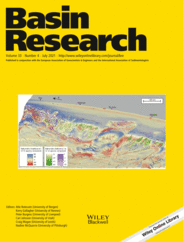
Full text loading...
 , Kamal’deen O. Omosanya2
, Kamal’deen O. Omosanya2 , Ovie Emmanuel Eruteya3, Kalachand Sain1
, Ovie Emmanuel Eruteya3, Kalachand Sain1
This work examines the mode of basal to substrate interaction, and flow dynamics of recurrent mass wasting events from a high‐quality 3D seismic reflection data. The Taranaki Basin, offshore New Zealand offers a unique environment to understand these processes, as the Neogene succession of the area preserves vertical stacks of mass transport deposits (MTDs) from the Miocene to Pliocene. The approach used here combines seismic interpretation of the basal shear zones (BSZs) of the MTD, seismic attribute analyses and colour rendering of both RMS amplitude and energy gradient maps. The five mass transport deposits are characterized into blocky‐MTDs consisting of moderate to high amplitude and variably deformed rafted blocks, and chaotic masses composed of slides and debris flow deposits. Classic examples of kinematic indicators at the BSZ of the MTDs akin to free‐slip flow processes such as liquefaction, hydroplaning and shear wetting are convolute flow fabrics and basal shear zone cut‐offs (fractures). Striations, grooves, mega scours, U‐ and V‐shaped scours, substrate erosion, monkey fingers (peel backs), substrate deformation and shearing are associated with no‐slip flows, suggesting that the mass movements efficiently interacted with the underlying substrate. Importantly, the intersection of different kinematic indicators along the BSZs of all the MTDs suggests an overlap of flow regimes, flow overprinting and transformation during mass movement. Although basal tooling by rafted blocks seems dominant during remobilization of the blocky MTDs, the presence of other kinematic indicators signifies combined mechanisms involving both free‐flow and no‐slip processes during their translation. The classification scheme evaluated here innovatively shows mass movements habitually occur through a combination of flow mechanisms rather than an independent flow regime.
,Panel a: Conceptual classification of mass movements into free‐flow and no‐slip flow (redrawn after Sobiesiak et al., 2018). Panel b: Kinematic indicators observed in the study area include variably oriented convolute fabrics, basal shear zone fractures (cut‐offs or cracks), striations, grooves and monkey fingers (responsible for peeling back of the BSZs). Panel c‐ Classification of the five interpreted mass transport deposits into those with free flow and no‐slip flow. The BSZ for MTD 1, 3, 4 and 5 is marked using blue, green, pink and orange lines.

Article metrics loading...

Full text loading...
References


Data & Media loading...

